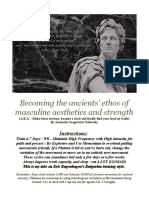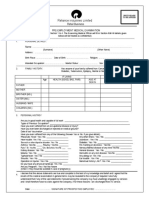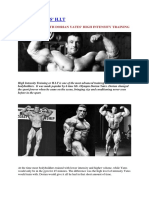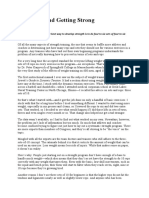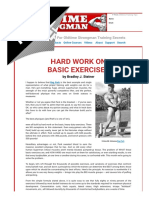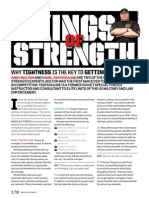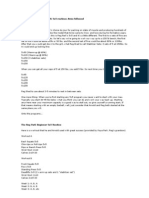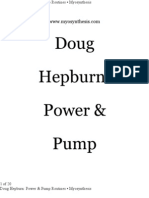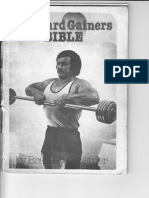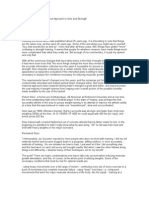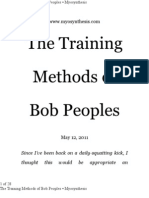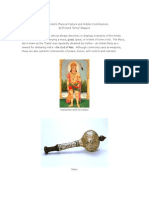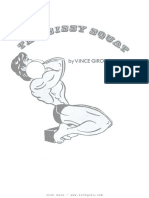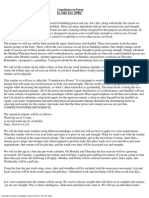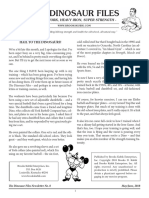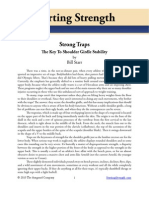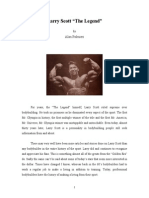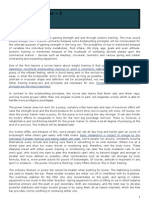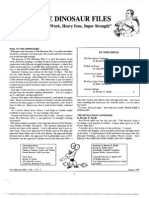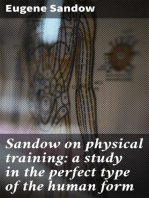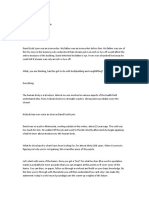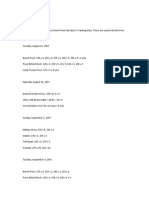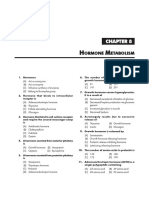50%(2)50% found this document useful (2 votes)
1K viewsAbbreviated Workout
Abbreviated Workout
Uploaded by
popeyeballinaThis document discusses abbreviated workouts that produce excellent strength training results with limited time. It describes workouts from early 20th century strength athletes Mark Berry, Joseph Curtis Hise, and Peary Rader that involved 1-2 exercises performed for high repetitions, such as one set of 20 squats. These short routines helped Berry gain 50 pounds and others much more, despite their busy lives. The document also outlines abbreviated routines using resistance bands that can provide a full-body workout when combined with exercises like front squats and good mornings attached to a baseboard.
Copyright:
© All Rights Reserved
Available Formats
Download as PDF, TXT or read online from Scribd
Abbreviated Workout
Abbreviated Workout
Uploaded by
popeyeballina50%(2)50% found this document useful (2 votes)
1K views4 pagesThis document discusses abbreviated workouts that produce excellent strength training results with limited time. It describes workouts from early 20th century strength athletes Mark Berry, Joseph Curtis Hise, and Peary Rader that involved 1-2 exercises performed for high repetitions, such as one set of 20 squats. These short routines helped Berry gain 50 pounds and others much more, despite their busy lives. The document also outlines abbreviated routines using resistance bands that can provide a full-body workout when combined with exercises like front squats and good mornings attached to a baseboard.
Original Description:
basic weight training for size and strength
Copyright
© © All Rights Reserved
Available Formats
PDF, TXT or read online from Scribd
Share this document
Did you find this document useful?
Is this content inappropriate?
This document discusses abbreviated workouts that produce excellent strength training results with limited time. It describes workouts from early 20th century strength athletes Mark Berry, Joseph Curtis Hise, and Peary Rader that involved 1-2 exercises performed for high repetitions, such as one set of 20 squats. These short routines helped Berry gain 50 pounds and others much more, despite their busy lives. The document also outlines abbreviated routines using resistance bands that can provide a full-body workout when combined with exercises like front squats and good mornings attached to a baseboard.
Copyright:
© All Rights Reserved
Available Formats
Download as PDF, TXT or read online from Scribd
Download as pdf or txt
50%(2)50% found this document useful (2 votes)
1K views4 pagesAbbreviated Workout
Abbreviated Workout
Uploaded by
popeyeballinaThis document discusses abbreviated workouts that produce excellent strength training results with limited time. It describes workouts from early 20th century strength athletes Mark Berry, Joseph Curtis Hise, and Peary Rader that involved 1-2 exercises performed for high repetitions, such as one set of 20 squats. These short routines helped Berry gain 50 pounds and others much more, despite their busy lives. The document also outlines abbreviated routines using resistance bands that can provide a full-body workout when combined with exercises like front squats and good mornings attached to a baseboard.
Copyright:
© All Rights Reserved
Available Formats
Download as PDF, TXT or read online from Scribd
Download as pdf or txt
You are on page 1of 4
At a glance
Powered by AI
The passage discusses several abbreviated workouts from the 1930s that focused on one or two exercises and produced significant strength and muscle gains. Some of the core exercises mentioned were squats, deadlifts, and presses.
Mark Berry recommended a workout with one set of curls, one set of presses, and one set of 20 squats. Joseph Curtis Hise and Peary Rader transformed their physiques using abbreviated squatting workouts. Peary Rader later recommended a workout with pressing, rowing, and one set of 20 squats.
Squats, deadlifts, and presses were core exercises recommended. Squats in particular were seen as very effective when performed for high repetitions, such as 20 reps.
The Abbreviated Workout
has proved to be the way for-
ward for many a working
man finding himself with little
time to train, or perhaps too
little energy for regular train-
ing on a full programme. For-
tunately, this problem has
been addressed over the last
100 years by a number of
wonderfully far sighted men
such as Mark Berry, Joseph
Curtis Hise and Peary Rad-
er, to name just three. They
all made excellent progress
in their personal training, as
did many of their pupils, and
today we find that Pavel
Tsatsouline, Russian
strength and conditioning
trainer and great admirer of
the old time strength teach-
ers, advocates an abbreviat-
ed workout as a result-
producing way of making
progress in strength training.
Let us look at a few short
workouts that have produced
excellent results, if worked
hard and coupled with a
nourishing diet and adequate
rest. Back in the 1930s, Mark
Berry was a very prolific iron
game writer, and also editor
of the popular Strength mag-
azine, as well as coach to
the American Olympic
Weightlifting Team. Whilst
training at Siegmund Klein's
gym in New York, he noticed
another fellow training. It was
Henry (Milo) Steinborn, prob-
ably the strongest man on
the American Weightlifting
Scene at that time. Henry
was performing Squats with
around 500 lbs, rocking the
barbell onto his shoulders
unassisted before commenc-
ing his first Squat, and Mark
Berry quickly linked Henry's
strenuous leg and back exer-
cise (the Squat) to the devel-
opment of a more powerful
physique.
It seems unbelievable today
that at that time, no-one
seems to have given much
thought to the use of squat
racks to make the positioning
of the barbell easier and to
enable the user to handle a
much heavier poundage.
Mark wrote an article for the
Strength magazine, which
included a drawing showing
how to make a home-made
squat rack. The article ad-
vised a short workout con-
sisting of one set of Curls,
and one set of Press On
Back, followed by one set of
20 Squats that would leave
you breathing heavily, and
finishing off with one set of
20 light Breathing Pullovers.
The whole workout only took
about 15 minutes. Mark
would also advise consum-
ing as much extra nourish-
ment as you could afford.
Mark Berry was a small
boned man with a slim phy-
sique, and he had not gained
a pound in bodyweight for
years, but by following his
own advice, he increased his
bodyweight from 130 lbs to
180 lbs, along with a major
increase in his overall
strength. Many others who
had taken his advice gained
a lot more. Two of them, Jo-
seph Curtis Hise and Peary
Rader, both transformed
their physiques and strength
levels, and Joe Hise who is
credited with popularising the
practice of taking 3 to 6 deep
breaths between squats, de-
veloped a very large and im-
pressive physique and the
ability to Deadlift 700 lbs and
Squat 20 reps with over 400
lbs. He achieved this despite
working very hard for his liv-
ing in various mines, and
sometimes even working a
By Ron Tyrrell
MARK BERRY
3
double shift! He helped many
hundreds of people to im-
prove their training methods
with no financial gain to him-
self, and he truly became
one of the great unsung he-
roes of the iron game.
Peary Rader also trans-
formed himself with the ab-
breviated Squat workout,
from a bodyweight of 128 lbs
to over 200 lbs, after many
years with no gains. He later
developed a workout for all-
round power and develop-
ment that consisted of Bench
Pressing four sets of 6 to 8
repetitions, Bent Forward
Rowing four sets of 6 to 8
reps, and one 20 rep sets of
Squats, followed by a light
set of Pullovers lying on a
bench.
Both Hise and Rader recom-
mended drinking at least four
pints of milk a day, to get the
best results. Peary Rader
went on to publish his Iron-
man magazine for fifty years,
and always recommended
the 20 repetition Squat
workout for producing the
best balance between mus-
cle strength and stamina.
Through the medium of his
magazine, he also recom-
mended the Deadlift as an
excellent power and muscle
builder. Not for nothing did
that great British old timer,
holder of many weightlifting
records, W A Pullum, refer to
the Deadlift as "the funda-
mental test of man's bodily
strength". The type of
strength gained from con-
centrating on this exercise
seems to translate quite
quickly into other strength
feats. Peary Rader recom-
mended a brief workout con-
sisting of one set of Bench
Henry Milo Steinborn, repetition squatting with 448lbs, 1930
JOSEPH CURTIS HISE
4
Presses and one set of Bar-
bell Curls, both for 10 to 12
repetitions, then a 20 rep set
of Deadlifts followed by a
very light set of Barbell Pullo-
vers, lying on a bench. He
recommended that 3 to 6
deep breaths be taken be-
tween each Deadlift. Mr Rad-
er had reservations about
using the Deadlift in this
strenuous manner, because
of the compression effect by
the arms on the sides of the
chest, so he would recom-
mend that between each
repetition you replace the
barbell back on the floor,
stand upright, and take your
3 to 6 deep breaths. He also
cautioned us to use good
form in the Deadlift with the
back flat and the hips low,
lifting with the legs as much
as possible.
Excellent results in strength
and muscle gains were re-
ported; the most outstanding
was a professional strong-
man by the name of Harold
Ansorge, who gained 100 lbs
on his Personal Best Deadlift
and 20 lbs of powerful mus-
cle in a very short time. Con-
centrating on either the
Squat or the Deadlift as their
Core Exercise induced an
overall improvement in
strength and muscle by all
who were prepared to work
hard on these short
workouts. Remember, with
all these abbreviated
workouts, start with a light
poundage and allow 2 to 3
weeks to work up to the
stage where you are working
hard to complete the last 2 to
3 repetitions, and try to add 5
lbs per week to your Core
Exercise bar. Do two or three
workouts a week.
Let us now spare a thought
for that "forgotten man" of
physical culture, the enthusi-
ast who works long hours
with many family commit-
ments, does not have much
spare energy, no time to visit
a gym' and no spare space
at home for a barbell. He
may well find the answer by
investing in a good quality
set of strands. Now, I must
admit it took me a few years
to be converted to the use of
strands, but I became con-
vinced of their value by the
PEARY RADER
5
writings of Leo Bowes of Ire-
land, Dave Webster OBE of
Scotland, and the help and
encouragement I received
from England's Jim Bartlett,
who has trained many great
strandpullers. The problem I
found with strands was how
to give the legs and lower
back a good workout. You
will not get as powerful a
workout for these body parts
as you would with weights.
However, with the aid of a
baseboard consisting of a
piece of wood 36 ins. by 9
ins. by 3 in. thick, and a few
strategically placed eye
hooks, you can do front
Squats for the thighs, and
the Good Morning exercise
for the lower back, by hold-
ing the strands with both
hands at the base of the
neck in the position as illus-
trated by that great old time
strand puller Alfred Danks,
and you will find that you get
a surprisingly good workout.
In keeping with the
"abbreviated" principle, the
rest of your strand workout
should consist of a few well
known strand exercises,
such as -
(1) Press Behind Back,
(2) Overhead Downward Pull
to the Back of the Neck,
(3) Front Chest Pull,
(4) Single Arms Curl: one set
each for 10 to 20 repetitions.
When 20 are easy, add a
strand and start off again
with 10 repetitions. Do three
or four workouts a week.
Alfred Danks, front squat with strands attached to a baseboard
(1) Press Behind Back
(2) Overhead Downward Pull to
the Back of the Neck,
(3) Front Chest Pull
(4) Single Arms Curl
6
You might also like
- Vasilov BulgarianDocument6 pagesVasilov BulgarianAlexander G. VasilovskyNo ratings yet
- Advanced PHA by Bob GajdaDocument3 pagesAdvanced PHA by Bob Gajdaryan9871100% (2)
- The Warrior Diet Fat Loss PlanDocument65 pagesThe Warrior Diet Fat Loss PlanAli Raza100% (3)
- Cyborgs and Space (Clynes & Kline)Document5 pagesCyborgs and Space (Clynes & Kline)telecult50% (2)
- Hepburns LawDocument51 pagesHepburns LawRocky SaracinoNo ratings yet
- Farmer Burns CourseDocument584 pagesFarmer Burns CourseSam Marcum100% (8)
- UsrsaplettersPre-Employment Medical FormDocument2 pagesUsrsaplettersPre-Employment Medical FormMahesh Yadav100% (1)
- Brooks Kubik - Dinosaur DietDocument22 pagesBrooks Kubik - Dinosaur Dietjacksparrow291% (11)
- Dorian YatesDocument15 pagesDorian Yatespopeyeballina89% (9)
- Enzymes Report Biology AS Core Practical Write Up EdexcelDocument7 pagesEnzymes Report Biology AS Core Practical Write Up EdexcelthariniNo ratings yet
- The Muscular SystemDocument61 pagesThe Muscular SystemAlfonso Robert100% (2)
- Bill Starr - Sets, Reps and Getting StrongDocument2 pagesBill Starr - Sets, Reps and Getting StrongTomSusNo ratings yet
- Bill Starr - Ageless StrengthDocument16 pagesBill Starr - Ageless Strengthbncns100% (2)
- John Christy Hard Gainer Articles CompilationDocument160 pagesJohn Christy Hard Gainer Articles CompilationKeith James100% (2)
- Reg ParkDocument10 pagesReg ParkSteve Messenger91% (11)
- Annotated Bibliography - Dream InterpretationDocument3 pagesAnnotated Bibliography - Dream Interpretationapi-316522252No ratings yet
- Hard Work On Basic Exercises by Bradley J. SteinerDocument4 pagesHard Work On Basic Exercises by Bradley J. SteinergastaoNo ratings yet
- Kings of Strength Part1Document2 pagesKings of Strength Part1Danko Kovačević50% (2)
- Power Mass TrainingDocument4 pagesPower Mass TrainingCLAVDIVSNo ratings yet
- Optimum Fitness: How to Use Your Muscles as Peripheral Hearts to Achieve Optimum Muscular and Aerobic FitnessFrom EverandOptimum Fitness: How to Use Your Muscles as Peripheral Hearts to Achieve Optimum Muscular and Aerobic FitnessNo ratings yet
- Peary Rader - The Rader Isometronic CourseDocument1 pagePeary Rader - The Rader Isometronic CourseIvan TaranovNo ratings yet
- Reg Park 5x5 2Document2 pagesReg Park 5x5 2Murilo AlmeidaNo ratings yet
- Odd Exercises For Physical VigorDocument19 pagesOdd Exercises For Physical VigorKristijan Kostić100% (1)
- Myo HepburnDocument20 pagesMyo HepburnPete Puza100% (5)
- 3 Lift ProgramsDocument2 pages3 Lift ProgramsStan Van Hoecke100% (1)
- Power Lifting SteinerDocument60 pagesPower Lifting Steinerjdg487No ratings yet
- Bill Starr - Look Strong, Be StrongDocument5 pagesBill Starr - Look Strong, Be Strongksksosk100% (3)
- Hard Gainers Bible Bradley SteinerDocument41 pagesHard Gainers Bible Bradley Steinerpopeyeballina100% (12)
- Bill Starr - Back To The RackDocument5 pagesBill Starr - Back To The RackTomSus100% (1)
- My Forty Years With The WorldDocument12 pagesMy Forty Years With The WorldTom HillNo ratings yet
- How Bruce Randall Trained - Randall & RaderDocument18 pagesHow Bruce Randall Trained - Randall & RaderCALF100% (2)
- Sensible Training - Dr. Ken E. LeistnerDocument6 pagesSensible Training - Dr. Ken E. LeistnerTyrone Jones100% (4)
- Training ProgramDocument3 pagesTraining Programhariso1995100% (1)
- Monday, July 27, 2009: The Bruce White Story - Wayne GallaschDocument8 pagesMonday, July 27, 2009: The Bruce White Story - Wayne GallaschbabagazeboNo ratings yet
- Brooks Kubik - Dinosaur TrainingDocument98 pagesBrooks Kubik - Dinosaur Traininganthem84No ratings yet
- Bob PeoplesDocument28 pagesBob PeoplesPete Puza100% (4)
- Secret Exercises of Physique Champions PDFDocument30 pagesSecret Exercises of Physique Champions PDFRajesh100% (1)
- India Physical Culture COL MERCEDEZDocument9 pagesIndia Physical Culture COL MERCEDEZmothafukka100% (2)
- Only The Fit SurviveDocument5 pagesOnly The Fit SurviveAlan Jay StanNo ratings yet
- Vince Gironda Sissy SquatDocument19 pagesVince Gironda Sissy SquatSnake Diet Ryan100% (2)
- John Kuc ArticlesDocument20 pagesJohn Kuc ArticlesSalvadore_Serbia100% (1)
- The Dinosaur Files: Hail To The Dinosaurs!Document13 pagesThe Dinosaur Files: Hail To The Dinosaurs!Piotr100% (1)
- Stronger Traps by Bill StarrDocument7 pagesStronger Traps by Bill StarrGino NavalNo ratings yet
- Larry Scott ArticleDocument14 pagesLarry Scott Articlefnandow4lNo ratings yet
- Neuro-Mass Jon BruneyDocument5 pagesNeuro-Mass Jon BruneyTheoNo ratings yet
- Bill Starr's Articles From Iron Man MagazineDocument63 pagesBill Starr's Articles From Iron Man MagazineCoco Bungbing100% (2)
- Bill Seno-Pushing For PowerDocument43 pagesBill Seno-Pushing For Powerbamabob1100% (1)
- The Tight Tan Slacks of Dezso Ban - Super Training - Bradley J. SteinerDocument5 pagesThe Tight Tan Slacks of Dezso Ban - Super Training - Bradley J. SteinergastaoNo ratings yet
- 15 Things I Learned From Sergio Oliva SRDocument6 pages15 Things I Learned From Sergio Oliva SRFabiano Lacerda100% (1)
- Reeves RoutineDocument1 pageReeves Routinecabuonav100% (2)
- Dino Files, Issue 1 - Aug 1997Document8 pagesDino Files, Issue 1 - Aug 1997Bhupathi Raju Vijayanand100% (4)
- Atomic Fitness: The Alternative to Drugs, Steroids, Wacky Diets, and Everything Else That's FailedFrom EverandAtomic Fitness: The Alternative to Drugs, Steroids, Wacky Diets, and Everything Else That's FailedNo ratings yet
- The Official Prison Fit Guidebook: Forging a Prison Fit Life, #1From EverandThe Official Prison Fit Guidebook: Forging a Prison Fit Life, #1No ratings yet
- Sandow on physical training: a study in the perfect type of the human formFrom EverandSandow on physical training: a study in the perfect type of the human formNo ratings yet
- The Mustache Workout: Man Up Your Training - Bigger, Stronger, LeanerFrom EverandThe Mustache Workout: Man Up Your Training - Bigger, Stronger, LeanerNo ratings yet
- Iron Legends: The Training and Diet Principles of Vince Gironda and Charles GlassFrom EverandIron Legends: The Training and Diet Principles of Vince Gironda and Charles GlassNo ratings yet
- Mike Mentzer MeetingDocument6 pagesMike Mentzer MeetingpopeyeballinaNo ratings yet
- TheMegaSizeMethod 6-12-25Document22 pagesTheMegaSizeMethod 6-12-25popeyeballinaNo ratings yet
- Sandbag Construction KitDocument8 pagesSandbag Construction KitRomán UrrutiaNo ratings yet
- MB 3Document7 pagesMB 3popeyeballinaNo ratings yet
- Mentzer WorkoutDocument7 pagesMentzer Workoutpopeyeballina100% (6)
- Pat Casey WorkoutDocument7 pagesPat Casey Workoutpopeyeballina100% (1)
- Integumentary SystemDocument7 pagesIntegumentary SystemLei Jenevive UmbayNo ratings yet
- Daisy Ursino's Portfolio: Bruce RiddellDocument95 pagesDaisy Ursino's Portfolio: Bruce Riddellapi-404780243No ratings yet
- Anatomy of Female Internal Genital OrganDocument18 pagesAnatomy of Female Internal Genital OrganVandana Liju Dev VasudevanNo ratings yet
- Biology 1 - 12 - Q1 - M6Document15 pagesBiology 1 - 12 - Q1 - M6Artlyne BunuanNo ratings yet
- H H H H H M M M M M: Ormone Ormone Ormone Ormone Ormone ET ET ET ET Etabolism Abolism Abolism Abolism AbolismDocument28 pagesH H H H H M M M M M: Ormone Ormone Ormone Ormone Ormone ET ET ET ET Etabolism Abolism Abolism Abolism AbolismHoth HothNo ratings yet
- 9781316631010excerpt9781316631010 Excerpt PDFDocument10 pages9781316631010excerpt9781316631010 Excerpt PDFAkyinnar ThomasNo ratings yet
- Ventilator GraphicsDocument57 pagesVentilator GraphicsDavid TNo ratings yet
- Kindergarten RhymesDocument15 pagesKindergarten RhymesAkshit R Shah100% (1)
- Guidelines On Vertigo and DizzinessDocument59 pagesGuidelines On Vertigo and DizzinessEcaterina ChiriacNo ratings yet
- The Shat Karmas and Hatha Yoga KriyasDocument36 pagesThe Shat Karmas and Hatha Yoga KriyasDeeutza SweetNo ratings yet
- NEET PG 2023 Solved PaperDocument139 pagesNEET PG 2023 Solved PapersaravananNo ratings yet
- Femoral Neck FracturesDocument10 pagesFemoral Neck FracturesMorshed Mahbub AbirNo ratings yet
- Care For Dialysis PatientsDocument18 pagesCare For Dialysis PatientsHemanth PrakashNo ratings yet
- Pineal Gland: By: Delgado, Divine GraceDocument20 pagesPineal Gland: By: Delgado, Divine GraceMuhammad AdnanNo ratings yet
- Final Exam Study ProblemsDocument6 pagesFinal Exam Study Problemsaboodh123No ratings yet
- Biology Life On Earth With Physiology 11Th Edition Audesirk Test Bank Full Chapter PDFDocument40 pagesBiology Life On Earth With Physiology 11Th Edition Audesirk Test Bank Full Chapter PDFodetteisoldedfe100% (17)
- A&P CH 1-3 ReviewDocument4 pagesA&P CH 1-3 ReviewAmy HalickNo ratings yet
- Chronopharmacokinetics and Time Dependent PharmacokineticsDocument12 pagesChronopharmacokinetics and Time Dependent Pharmacokineticsfahima purniNo ratings yet
- Toshio Moritani, Tetsuya Kimura, Taku Hamada, Narumi Nagai - Electrophysiology and Kinesiology For Health and DiseaseDocument16 pagesToshio Moritani, Tetsuya Kimura, Taku Hamada, Narumi Nagai - Electrophysiology and Kinesiology For Health and DiseaseEmil CotenescuNo ratings yet
- Thermal and AnesthesiaDocument11 pagesThermal and AnesthesiaancillaagraynNo ratings yet
- Excretory System of InvertebratesDocument4 pagesExcretory System of InvertebratesHINA SHAHZADINo ratings yet
- General Surgery MCQDocument190 pagesGeneral Surgery MCQلمسة مصمم100% (1)
- Repiratory System: Presented by Group 3: Lacap, Lopez, Medina, MarceloDocument8 pagesRepiratory System: Presented by Group 3: Lacap, Lopez, Medina, MarceloAj LacapNo ratings yet
- An Introduction To Medical EnglishDocument10 pagesAn Introduction To Medical EnglishVilmar del RosarioNo ratings yet
- Chemical Reaction NotesDocument2 pagesChemical Reaction NotesalchriwNo ratings yet
